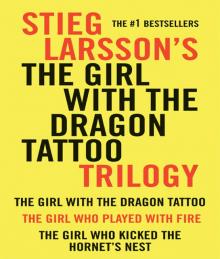- Home
- Stieg Larsson
The Girl With the Dragon Tattoo Trilogy Bundle Page 2
The Girl With the Dragon Tattoo Trilogy Bundle Read online
Page 2
Despite the seriousness of the situation, neither Blomkvist nor the older journalists could help smiling. He exchanged glances with TV4. How does it feel? The half-witted sports reporter shoves his microphone in the face of the Breathless Athlete on the finishing line.
“I can only regret that the court did not come to a different conclusion,” he said a bit stuffily.
“Three months in gaol and 150,000 kronor damages. That’s pretty severe,” said She from TV4.
“I’ll survive.”
“Are you going to apologise to Wennerström? Shake his hand?”
“I think not.”
“So you still would say that he’s a crook?” Dagens Nyheter.
The court had just ruled that Blomkvist had libelled and defamed the financier Hans-Erik Wennerström. The trial was over and he had no plans to appeal. So what would happen if he repeated his claim on the courthouse steps? Blomkvist decided that he did not want to find out.
“I thought I had good reason to publish the information that was in my possession. The court has ruled otherwise, and I must accept that the judicial process has taken its course. Those of us on the editorial staff will have to discuss the judgement before we decide what we’re going to do. I have no more to add.”
“But how did you come to forget that journalists actually have to back up their assertions?” She from TV4. Her expression was neutral, but Blomkvist thought he saw a hint of disappointed repudiation in her eyes.
The reporters on site, apart from the boy from Dagens Nyheter, were all veterans in the business. For them the answer to that question was beyond the conceivable. “I have nothing to add,” he repeated, but when the others had accepted this TV4 stood him against the doors to the courthouse and asked her questions in front of the camera. She was kinder than he deserved, and there were enough clear answers to satisfy all the reporters still standing behind her. The story would be in the headlines but he reminded himself that they were not dealing with the media event of the year here. The reporters had what they needed and headed back to their respective newsrooms.
He considered walking, but it was a blustery December day and he was already cold after the interview. As he walked down the courtroom steps, he saw William Borg getting out of his car. He must have been sitting there during the interview. Their eyes met, and then Borg smiled.
“It was worth coming down here just to see you with that paper in your hand.”
Blomkvist said nothing. Borg and Blomkvist had known each other for fifteen years. They had worked together as cub reporters for the financial section of a morning paper. Maybe it was a question of chemistry, but the foundation had been laid there for a lifelong enmity. In Blomkvist’s eyes, Borg had been a third-rate reporter and a troublesome person who annoyed everyone around him with crass jokes and made disparaging remarks about the more experienced, older reporters. He seemed to dislike the older female reporters in particular. They had their first quarrel, then others, and anon the antagonism turned personal.
Over the years, they had run into each other regularly, but it was not until the late nineties that they became serious enemies. Blomkvist had published a book about financial journalism and quoted extensively a number of idiotic articles written by Borg. Borg came across as a pompous ass who got many of his facts upside down and wrote homages to dot-com companies that were on the brink of going under. When thereafter they met by chance in a bar in Söder they had all but come to blows. Borg left journalism, and now he worked in PR—for a considerably higher salary—at a firm that, to make things worse, was part of industrialist Hans-Erik Wennerström’s sphere of influence.
They looked at each other for a long moment before Blomkvist turned on his heel and walked away. It was typical of Borg to drive to the courthouse simply to sit there and laugh at him.
The number 40 bus braked to a stop in front of Borg’s car and Blomkvist hopped on to make his escape. He got off at Fridhemsplan, undecided what to do. He was still holding the judgement document in his hand. Finally he walked over to Kafé Anna, next to the garage entrance leading underneath the police station.
Half a minute after he had ordered a caffe latte and a sandwich, the lunchtime news came on the radio. The story followed that of a suicide bombing in Jerusalem and the news that the government had appointed a commission to investigate the alleged formation of a new cartel within the construction industry.
Journalist Mikael Blomkvist of the magazine Millennium was sentenced this morning to 90 days in gaol for aggravated libel of industrialist Hans-Erik Wennerström. In an article earlier this year that drew attention to the so-called Minos affair, Blomkvist claimed that Wennerström had used state funds intended for industrial investment in Poland for arms deals. Blomkvist was also sentenced to pay 150,000 SEK in damages. In a statement, Wennerström’s lawyer Bertil Camnermarker said that his client was satisfied with the judgement. It was an exceptionally outrageous case of libel, he said.
The judgement was twenty-six pages long. It set out the reasons for finding Blomkvist guilty on fifteen counts of aggravated libel of the businessman Hans-Erik Wennerström. So each count cost him ten thousand kronor and six days in gaol. And then there were the court costs and his own lawyer’s fee. He could not bring himself to think about all the expenses, but he calculated too that it might have been worse; the court had acquitted him on seven other counts.
As he read the judgement, he felt a growing heaviness and discomfort in his stomach. This surprised him. As the trial began he knew that it would take a miracle for him to escape conviction, and he had become reconciled to the outcome. He sat through the two days of the trial surprisingly calm, and for eleven more days he waited, without feeling anything in particular, for the court to finish deliberating and to come up with the document he now held in his hand. It was only now that a physical unease washed over him.
When he took a bite of his sandwich, the bread seemed to swell up in his mouth. He could hardly swallow it and pushed his plate aside.
This was the first time that Blomkvist had faced any charge. The judgement was a trifle, relatively speaking. A lightweight crime. Not armed robbery, murder, or rape after all. From a financial point of view, however, it was serious—Millennium was not a flagship of the media world with unlimited resources, the magazine barely broke even—but the judgement did not spell catastrophe. The problem was that Blomkvist was one of Millennium’s part owners, and at the same time, idiotically enough, he was both a writer and the magazine’s publisher. The damages of 150,000 kronor he would pay himself, although that would just about wipe out his savings. The magazine would take care of the court costs. With prudent budgeting it would work out.
He pondered the wisdom of selling his apartment, though it would break his heart. At the end of the go-go eighties, during a period when he had a steady job and a pretty good salary, he had looked around for a permanent place to live. He ran from one apartment showing to another before he stumbled on an attic flat of 700 square feet right at the end of Bellmansgatan. The previous owner was in the middle of making it liveable but suddenly got a job at a dot-com company abroad, and Blomkvist was able to buy it inexpensively.
He rejected the original interior designer’s sketches and finished the work himself. He put money into fixing up the bathroom and the kitchen area, but instead of putting in a parquet floor and interior walls to make it into the planned two-room apartment, he sanded the floor-boards, whitewashed the rough walls, and hid the worst patches behind two watercolours by Emanuel Bernstone. The result was an open living space, with the bedroom area behind a bookshelf, and the dining area and the living room next to the small kitchen behind a counter. The apartment had two dormer windows and a gable window with a view of the rooftops towards Gamla Stan, Stockholm’s oldest section, and the water of Riddarfjärden. He had a glimpse of water by the Slussen locks and a view of City Hall. Today he would never be able to afford such an apartment, and he badly wanted to hold on to it.
But th
at he might lose the apartment was nothing beside the fact that professionally he had received a real smack in the nose. It would take a long time to repair the damage—if indeed it could ever be repaired.
It was a matter of trust. For the foreseeable future, editors would hesitate to publish a story under his byline. He still had plenty of friends in the business who would accept that he had fallen victim to bad luck and unusual circumstances, but he was never again going to be able to make the slightest mistake.
What hurt most was the humiliation. He had held all the trumps and yet he had lost to a semi-gangster in an Armani suit. A despicable stock-market speculator. A yuppie with a celebrity lawyer who sneered his way through the whole trial.
How in God’s name had things gone so wrong?
The Wennerström affair had started out with such promise in the cockpit of a thirty-seven-foot Mälar-30 on Midsummer Eve a year and a half earlier. It began by chance, all because a former journalist colleague, now a PR flunky at the county council, wanted to impress his new girlfriend. He had rashly hired a Scampi for a few days of romantic sailing in the Stockholm archipelago. The girlfriend, just arrived from Hallstahammar to study in Stockholm, had agreed to the outing after putting up token resistance, but only if her sister and her sister’s boyfriend could come too. None of the trio from Hallstahammar had any sailing experience, and unfortunately Blomkvist’s old colleague had more enthusiasm than experience. Three days before they set off he had called in desperation and persuaded him to come as a fifth crew member, one who knew navigation.
Blomkvist had not thought much of the proposal, but he came around when promised a few days of relaxation in the archipelago with good food and pleasant company. These promises came to naught, and the expedition turned into more of a disaster than he could have imagined. They had sailed the beautiful but not very dramatic route from Bullandö up through Furusund Strait at barely 9 knots, but the new girlfriend was instantly seasick. Her sister started arguing with her boyfriend, and none of them showed the slightest interest in learning the least little thing about sailing. It quickly became clear that Blomkvist was expected to take charge of the boat while the others gave him well-intentioned but basically meaningless advice. After the first night in a bay on Ängsö he was ready to dock the boat at Furusund and take the bus home. Only their desperate appeals persuaded him to stay.
At noon the next day, early enough that there were still a few spaces available, they tied up at the visitors’ wharf on the picturesque island of Arholma. They had thrown some lunch together and had just finished when Blomkvist noticed a yellow fibreglass M-30 gliding into the bay using only its mainsail. The boat made a graceful tack while the helmsman looked for a spot at the wharf. Blomkvist too scanned the space around and saw that the gap between their Scampi and an H-boat on the starboard side was the only slot left. The narrow M-30 would just fit. He stood up in the stern and pointed; the man in the M-30 raised a hand in thanks and steered towards the wharf. A lone sailor who was not going to bother starting up the engine, Blomkvist noticed. He heard the rattle of the anchor chain and seconds later the main came down, while the skipper moved like a scalded cat to guide the rudder straight for the slot and at the same time ready the line from the bow.
Blomkvist climbed up on the railing and held out a hand for the painter. The new arrival made one last course correction and glided perfectly up to the stern of the Scampi, by now moving very slowly. It was only as the man tossed the painter to Blomkvist that they recognised each other and smiled in delight.
“Hi, Robban. Why don’t you use your engine so you don’t scrape the paint off all the boats in the harbour?”
“Hi, Micke. I thought there was something familiar about you. I’d love to use the engine if I could only get the piece of crap started. It died two days ago out by Rödlöga.”
They shook hands across the railings.
An eternity before, at Kungsholmen school in the seventies, Blomkvist and Robert Lindberg had been friends, even very good friends. As so often happens with school buddies, the friendship faded after they had gone their separate ways. They had met maybe half a dozen times in the past twenty years, the last one seven or eight years ago. Now they studied each other with interest. Lindberg had tangled hair, was tanned and had a two-week-old beard.
Blomkvist immediately felt in much better spirits. When the PR guy and his silly girlfriend went off to dance around the Midsummer pole in front of the general store on the other side of the island, he stayed behind with his herring and aquavit in the cockpit of the M-30, shooting the breeze with his old school pal.
Sometime that evening, after they had given up the battle with Arholma’s notorious mosquitoes and moved down to the cabin, and after quite a few shots of aquavit, the conversation turned to friendly banter about ethics in the corporate world. Lindberg had gone from school to the Stockholm School of Economics and into the banking business. Blomkvist had graduated from the Stockholm School of Journalism and devoted much of his professional life to exposing corruption in the banking and business world. Their talk began to explore what was ethically satisfactory in certain golden parachute agreements during the nineties. Lindberg eventually conceded there were one or two immoral bastards in the business world. He looked at Blomkvist with an expression that was suddenly serious.
“Why don’t you write about Hans-Erik Wennerström?”
“I didn’t know there was anything to write about him.”
“Dig. Dig, for God’s sake. How much do you know about the AIA programme?”
“Well, it was a sort of assistance programme in the nineties to help industry in the former Eastern Bloc countries get back on their feet. It was shut down a couple of years ago. It’s nothing I’ve ever looked into.”
“The Agency for Industrial Assistance was a project that was backed by the state and administered by representatives of about a dozen big Swedish firms. The AIA obtained government guarantees for a number of projects initiated in agreement with the governments in Poland and the Baltics. The Swedish Trade Union Confederation, LO, also joined in as a guarantor that the workers’ movement in the East would be strengthened as well by following the Swedish model. In theory, it was an assistance project that built on the principle of offering help for self-help, and it was supposed to give the regimes in the East the opportunity to restructure their economies. In practice, however, it meant that Swedish companies would get state subventions for going in and establishing themselves as part owners in companies in Eastern European countries. That goddammed minister in the Christian party was an ardent advocate of the AIA, which was going to set up a paper mill in Krakow and provide new equipment for a metals industry in Riga, a cement factory in Tallinn, and so on. The funds would be distributed by the AIA board, which consisted of a number of heavyweights from the banking and corporate world.”
“So it was tax money?”
“About half came from government contributions, and the banks and corporations put up the rest. But it was far from an ideal operation. The banks and industry were counting on making a sweet profit. Otherwise they damn well wouldn’t have bothered.”
“How much money are we talking about?”
“Hold on, listen to this. The AIA was dealing primarily with big Swedish firms who wanted to get into the Eastern European market. Heavy industries like ASEA Brown Boveri and Skanska Construction and the like. Not speculation firms, in other words.”
“Are you telling me that Skanska doesn’t do speculation? Wasn’t it their managing director who was fired after he let some of his boys speculate away half a billion in quick stock turnovers? And how about their hysterical property deals in London and Oslo?”
“Sure, there are idiots in every company the world over, but you know what I mean. At least those companies actually produce something. The backbone of Swedish industry and all that.”
“Where does Wennerström come into the picture?”
“Wennerström is the joker in the pack. Meanin
g that he’s a guy who turns up out of the blue, who has no background whatsoever in heavy industry, and who really has no business getting involved in these projects. But he has amassed a colossal fortune on the stock market and has invested in solid companies. He came in by the back door, so to speak.”
As he sat there in the boat, Blomkvist filled his glass with Reimersholms brandy and leaned back, trying to remember what little he knew about Wennerström. Born up in Norrland, where in the seventies he set up an investment company. He made money and moved to Stockholm, and there his career took off in the eighties. He created Wennerström-gruppen, the Wennerström Group, when they set up offices in London and New York and the company started to get mentioned in the same articles as Beijer. He traded stock and options and liked to make quick deals, and he emerged in the celebrity press as one of Sweden’s numerous billionaires with a city home on Strandvägen, a fabulous summer villa on the island of Värmdö, and an eighty-two-foot motor yacht that he bought from a bankrupt former tennis star. He was a bean counter, naturally, but the eighties was the decade of the bean counters and property speculators, and Wennerström had not made a significantly big splash. On the contrary, he had remained something of a man in the shadows among his peers. He lacked Jan Stenbeck’s flamboyance and did not spread himself all over the tabloids like Percy Barnevik. He said goodbye to real estate and instead made massive investments in the former Eastern Bloc. When the bubble burst in the nineties and one managing director after another was forced to cash in his golden parachute, Wennerström’s company came out of it in remarkably good shape. “A Swedish success story,” as the Financial Times called it.
“That was 1992,” Lindberg said. “Wennerström contacted AIA and said he wanted funding. He presented a plan, seemingly backed by interests in Poland, which aimed at establishing an industry for the manufacture of packaging for foodstuffs.”

 The Girl with the Dragon Tattoo
The Girl with the Dragon Tattoo The Girl Who Kicked the Hornet's Nest
The Girl Who Kicked the Hornet's Nest The Girl Who Played with Fire
The Girl Who Played with Fire The Girl with the Dragon Tattoo m(-1
The Girl with the Dragon Tattoo m(-1 The Girl who played with Fire m(-2
The Girl who played with Fire m(-2 Millennium 01 - The Girl with the Dragon Tattoo
Millennium 01 - The Girl with the Dragon Tattoo The Girl Who Kicked The Hornets’ Nest m(-3
The Girl Who Kicked The Hornets’ Nest m(-3 Millennium 02 - The Girl Who Played with Fire
Millennium 02 - The Girl Who Played with Fire Millennium 03 - The Girl Who Kicked the Hornet's Nest
Millennium 03 - The Girl Who Kicked the Hornet's Nest The Girl With the Dragon Tattoo Trilogy Bundle
The Girl With the Dragon Tattoo Trilogy Bundle![Millenium [02] The Girl Who Played With Fire Read online](http://i1.bookreadfree.com/i2/04/12/millenium_02_the_girl_who_played_with_fire_preview.jpg) Millenium [02] The Girl Who Played With Fire
Millenium [02] The Girl Who Played With Fire